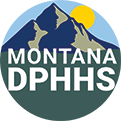FOR IMMEDIATE RELEASE
Date: October 28 2025
Contact: Jon Ebelt, Communications Director, DPHHS, (406) 444-0936, (406) 461-3757
jebelt@mt.gov
DPHHS Encourages Montanans to Prepare for Respiratory Illness this Fall and Winter
As Montana approaches the colder months and the start of another respiratory illness season, the Department of Public Health and Human Services (DPHHS) urges all Montanans to take preventative measures to defend against COVID-19, influenza (flu), pneumococcal pneumonia, and respiratory syncytial virus (RSV).
State health officials advise all Montanans to protect themselves and their families by prioritizing immunizations, practicing strong hygiene, staying home when sick, and seeking prompt testing and treatment.
Laboratory-confirmed cases of influenza have already been reported in Montana for the 2025-2026 respiratory illness season, which runs from October through May.
More than 15,600 people infected with influenza, including over 1,000 hospitalizations and 65 deaths, were reported to DPHHS during the 2024-2025 respiratory illness season.
Additionally, over 7,500 people infected with COVID-19 were reported in Montana, resulting in more than 600 hospitalizations and 51 deaths during this same period. This does not include data for individuals who did not receive testing by a provider or in a health care setting (e.g., individuals who tested positive using an at-home or over-the-counter COVID-19 or flu test kit).
The high number of respiratory illnesses highlights the importance of taking preventive measures to reduce the burden of illness in Montana.
DPHHS will maintain a Respiratory Virus Illness Dashboard to provide weekly data updates on the activity of COVID-19, influenza, and RSV across the state.
Vaccination is the most effective defense against the serious outcomes of respiratory diseases, including hospitalization or death from infections such as COVID-19, influenza, pneumococcal pneumonia, and RSV. While anyone can suffer a severe outcome, those at highest risk include older adults, infants, pregnant women, and individuals with weakened immune systems or chronic conditions (such as diabetes, cancer, or heart disease).
Fortunately, effective vaccines are widely available. Montanans should consult with a health care provider to determine their recommended vaccine options for the season. To find a vaccine nearby, contact your local health department, pharmacy, or other trusted health care provider.
- Updated COVID-19 vaccines are recommended based on individual-based decision-making for those six months and older.
- Influenza vaccines are recommended for everyone six months and older every season. Several influenza vaccines are approved for use. One dose provides protection for the entire season (October to May)
- Pneumococcal vaccines help protect against a deadly form of bacterial pneumonia, which is the most serious form of pneumococcal disease.
- Adults 50 years and older are eligible to receive RSV vaccines after discussion with their health care provider. Pregnant women between 32 and 36 weeks of pregnancy entering the RSV season may receive the RSV vaccine, which will also protect their infant.
- Infants under eight months old or who are between eight and 19 months with certain health conditions may receive an RSV antibody product.
Symptoms of COVID-19, flu, RSV, and other respiratory illnesses often share commonalities, including signs such as fever, cough, sore throat, headache, body aches, and fatigue. If an individual is experiencing symptoms or has tested positive, they should stay home and limit contact with others while sick.
Individuals at risk of severe illness should seek health care right away for testing and evaluation. This is critical because prompt treatment options are available that can help reduce the length and severity of the illness.
It is generally safe to return to daily activities only after the individual has been fever-free for a full 24 hours without the use of fever-reducing medication and has experienced an overall improvement in their symptoms.
Individuals may still be able to spread the virus that made them sick even if they are feeling better. Some people, such as those with immunocompromising conditions, may be able to spread the virus for an extended period of time. Montanans should take additional measures to prevent the spread of illness for five days after returning to normal daily activities, including:
- Wash your hands often with soap and water. If soap and water are unavailable, use an alcohol-based hand sanitizer containing at least 60% alcohol.
- Cover your mouth and nose with disposable tissue or your inner elbow whenever you cough or sneeze.
- Testing before you plan to be around others, especially those who are at risk of severe illness (e.g., pregnant women, older adults, infants, immunocompromised people). If you test positive, consider remaining home and away from others.
- If you cannot remain home and away from others, use a face mask if you will be around people in a close setting, especially those who are at risk of severe illness (e.g., pregnant women, older adults, infants, immunocompromised people).
Take steps to improve air quality, including moving group activities outside when weather permits, opening windows and doors for fresh air, and using a high-efficiency particulate air (HEPA) filter. Anyone experiencing severe or concerning symptoms—including trouble breathing, persistent chest pain or pressure, new confusion, or inability to stay awake—should immediately seek medical evaluation.

